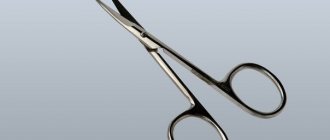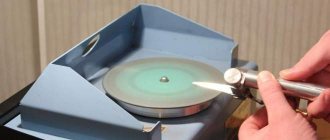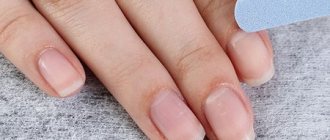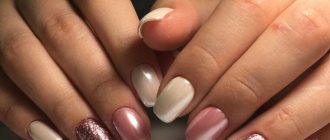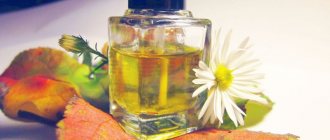What is hardware manicure
The essence of this type of manicure is the use of a special device with many attachments. With his help:
- the stratum corneum is removed;
- the shape of the nail bed is corrected;
- the cuticle is processed;
- hangnails are removed;
- the surface of the nail is leveled;
- The plate is given a soft natural shine.
The master selects removable cutters based on the condition of his hands and the goals he is pursuing. The faster the nozzle rotates, the greater the effect it produces.
Manicure machines vary in power, speed and included attachments. In some there are only five, in professional models this number is several times greater. The variety allows you to most accurately select a cutter for a specific problem.
How to file your nails correctly
Correctly designing your nails is important not only to ensure that the manicure turns out neat. Their health depends on this. Most girls believe that you need to move the file from side to side. They think that this way they will quickly give the nail plate the desired shape. But such technology will lead to its delamination.
Use a special soft tool to work on natural nails. The main rule is that you only need to work with a file in one direction. You also need to press the tool tightly enough to the nail so that it does not become loose and the plate does not delaminate. When you're done with the first step, be sure to use a soft buff to make the edges smoother.

Features and differences from other types of manicure
The main distinctive feature of hardware manicure is the exclusively “dry” procedure. No pre-steaming is required, reducing the risk of injury. The device can be used even with closely spaced vessels, when cutting the cuticle usually results in cuts.
If you use this care technique constantly, the rate of cuticle growth decreases. This allows you to go longer without repeating the procedure. Nails retain a well-groomed appearance for an average of 3-4 weeks.
Treatment with the device can be performed both in the salon and at home. For the second option, devices with speeds of up to 25 thousand rpm are quite suitable, while professional models come with an indicator of 30 thousand rpm.
When working with a machine, beginners often have problems with cuts. These are depressions on the surface of the nail that arose due to incorrect position of the device during the procedure, “overexposure” or incorrectly adjusted power. Only experience will help you avoid such troubles. Therefore, before starting to work on live nails, it is better to practice on extended or artificial ones.
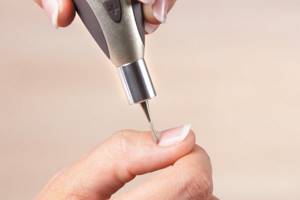
Precautionary measures
When performing a manicure that involves trimming the cuticle, take precautions.
- The cutting parts of the tools are well sharpened. This will avoid the occurrence of hangnails. Cuticles and rough skin growths will be carefully cut off without affecting the delicate areas of the skin.
- Carefully treat all instruments with disinfectants (alcohol, vodka, special compositions).
- Apply any antiseptic to your hands.
- Place sterile wipes, cotton wool pads, and hydrogen peroxide nearby for quick treatment of damage.
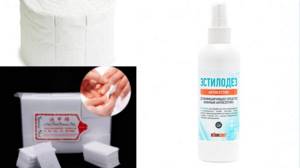
Indications and contraindications for hardware manicure
Experts recommend using the procedure for people:
- having a rough cuticle that grows quickly and is easily injured by sharp instruments during trimming techniques;
- with dull nail color without natural shine;
- with problematic nails that peel, break, and have an uneven “ribbed” surface.
Can be used without the listed symptoms. Hardware manicure will be useful for everyone who has no contraindications to it. And since the procedure does not affect the entire body as a whole, it is allowed even for people with chronic diseases, pregnant or lactating women.
All contraindications relate to problems with the hands themselves:
- fungus on the nails;
- inflammatory processes in the periungual ridges;
- mechanical damage to the nail surface;
- excessive thinness of the nail plates.
If in the first three cases you can get rid of contraindications by curing the nails or waiting for a healthy plate to grow, then the last reason is more serious. Excessive thinness of nails is associated with a physiological predisposition or lack of vitamins in the body. Grinding with a cutter in such a situation can lead to destruction of the insert.
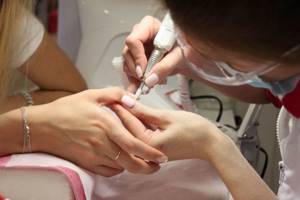
Square-oval nail shape
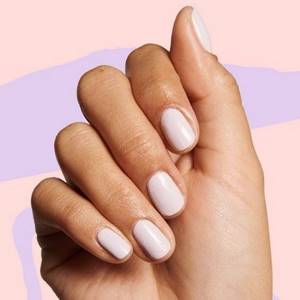
Another variety of the square: the corners are again soft, only the edge of the nail is not completely straight, but with a slight bend, which gives the output something between a square and an oval. Oddly enough, maintaining this shape is not so easy. You will definitely need a good eye - it is important to maintain the proportions and at the same time not go either into the usual “soft square” or into a full-fledged oval.
Who is suitable for square-oval nail shape:
There is no fundamental difference from the “soft square”, so the recommendations are exactly the same.
Beauty Recipes: How to Make DIY Coconut Bath Bombs
Pros and cons of hardware manicure
Hardware manicure has many advantages:
- Execution speed. Processing with the device does not require preliminary steaming, as in the classical technique, which significantly saves time. The entire process is automated, and the session lasts on average 20-40 minutes, depending on how hands are used.
- Safety. The likelihood of injuring the skin is virtually eliminated, since the procedure does not involve the use of sharp instruments. This also reduces the risk of infection. This is especially true for those with thin skin with closely spaced blood vessels.
- Duration of effect. Since the cuticle is not cut, it grows slower, making hands look well-groomed for up to several weeks. If you additionally regularly treat the cuticles with a tangerine wood stick, you can extend the effect for another week.
- Large selection of attachments. With the help of cutters you can work with both hands and rough skin of the feet. The caps also grind, polish, and give the desired shape to different types of nails. One device replaces many tools.
- Painless. The procedure does not cause pain even for those people who have a low sensitivity threshold. The only reason why you can feel pain is that the plate is too thin. However, with it, hardware manicure is contraindicated.
Hardware treatment of the cuticle: how to do it and what are the advantages
Hardware cuticle removal is somewhat akin to the European version of manicure. With this procedure, dead skin areas are only carefully removed, leaving the cuticle itself intact, unless this requires preliminary softening of the skin. Hand treatment with a cuticle remover is done only in a dry way. The bottom line is that the overgrown skin around the nail is removed with a special cuticle cutter.

Photo from the site: vseonogtyah.ru
This procedure has many advantages:
- With hardware nail treatment, less time is spent. On average, with enough experience, all nails can be put in order in 30 minutes. While a classic edged manicure can take up to 1.5 hours.
- The cuticle machine is safe in terms of possible injury and infection. A cuticle cutter, in fact, just exfoliates dead skin cells, while a trimmed manicure also affects “living areas,” which often leads to splitting, hence the risk of infection.
- Hardware cuticle removal does not require any preliminary work. In this case, there is no need to steam the skin, apply softening agents or remover to the cuticle. Everything is done on dry skin.
- Hardware manicure is a more delicate process and is an ideal option for people with thin cuticles or those with close blood vessels.
- Also, a cuticle machine is an ideal option for treating rough areas of the skin, where trimming, and even more so a European manicure, is difficult to cope with.
- After hardware removal, the cuticle grows back much more slowly, and there is no risk of burrs.
Photo from the site: manikyrru.tumblr.com
With all the advantages of this manicure technique, the disadvantages should also be noted:
- If the cutter is used ineptly to process the cuticle, there is a risk of causing injury to the nail plate, up to its complete perforation.
- The result is not clean enough. For many people, the cuticle is quite voluminous and in order to give an aesthetic appearance to the hands, it is better to cut it off.
- The device itself is expensive. Unlike edged and non-shaped manicure options, for hardware cuticle removal you will have to purchase an expensive device and additional milling attachments.
- A more complex equipment maintenance procedure. Cuticle cutters require constant hygienic care. They need to be cleaned and disinfected in a timely manner, but inept handling of them can lead to the fact that they can simply be damaged, and this will result in additional expenses.
Interesting
Many manicurists prefer to combine several cuticle processing techniques in their work. They often apply a cuticle remover, but prefer to cut it off. They prefer to do the most important work - removing the pterygium - using a cuticle cutter. In any case, the method does not matter as much as the result achieved.
Cons of hardware manicure
This technique also has disadvantages:
- Experience required. Without certain skills, it will be very difficult to conduct a session. Only practice will allow you to perform the procedure correctly and not injure the skin and nails with cuts. It is also difficult to select the necessary attachments without knowing their features and without being able to analyze the condition of the skin. Beginners cannot even hold the device at the right angle.
- The high cost of purchasing and maintaining the machine. A good device is not cheap. If you use it incorrectly, it will overheat and fail. Buying spare parts will again cost a pretty penny.
- Thorough disinfection. Disposable caps must be disposed of after the first use. Reusable cutters should be treated with antiseptic liquids after each use. Disinfection speeds up the process of grinding abrasive particles off the nozzles, so they have to be renewed.
Do I need to remove cuticles?
Most experts believe that it does not need to be removed because it performs a protective function. And not everyone is able to cut it correctly and accurately, and this can lead to the formation of burrs. Therefore, “European manicure” is becoming especially popular, in which the cuticle is carefully pushed back with an orange stick. Also apply special oils and creams to make her look healthy and well-groomed.
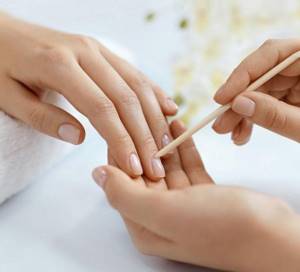
A must-have set of tools for a proper manicure
The basis of such care is a special machine with attachments, operating either from the mains or from a battery. The set can contain from 5 to 30 caps. They are installed on a special stand. Sometimes they have pockets in an organizer or case.
Required attachments:
- cone - to get rid of pterygium (skin film growing to the plate);
- cylinder-drum - to remove the previous coating;
- ball - for lifting and removing cuticles.
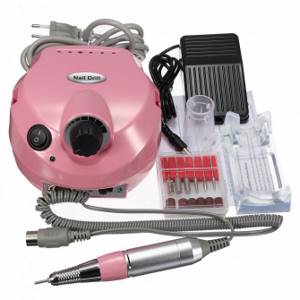
The rigidity of the caps must be taken into account. To indicate this parameter, manufacturers highlight them in color. Blue notches indicate the highest level of stiffness, red notches the lowest.
In addition to the device you will need:
- mask - to prevent dust particles from clogging the lungs;
- extractor hood is not necessary, but helps reduce the amount of dust in the air;
- brush – for removing dust from fingers;
- antiseptic liquid – disinfects and prevents infection;
- wooden stick - for forming the nail bed;
- degreaser and wipes;
- cuticle oil - for preliminary softening;
- file – for processing plates;
- varnish and decorative elements for covering nails - optional.
If varnish is applied, you will also need an ultraviolet lamp to dry it.
Recommendations for cutters from experienced specialists
For professional nail care you will need the following set of attachments:
- "Flame", "Bullet" or "Cone" with diamonds and red mark, to lift cuticles and cleanse rollers;
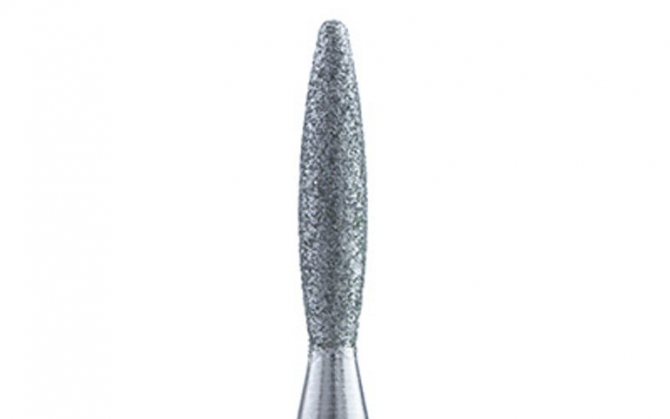
- cut off the cuticle and dead skin from the sides using a “Ball” with diamond chips, medium or miniature;
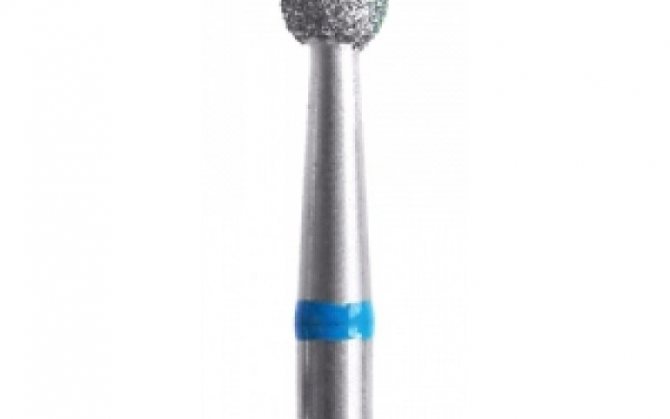
- The pterygium is cleaned with a diamond “Cone”;
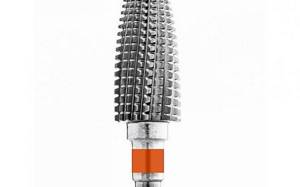
- the old coating is removed with ceramic “Corn”;
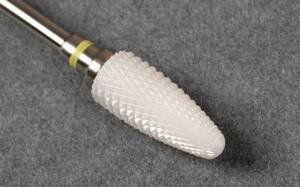
- if the nails are extended and trimming of the plates is required, then a carbide “Cylinder” is needed;

- Finish the job with sanding attachments.

How to choose the right machine for hardware manicure
Before purchasing a specific model, you need to determine the purpose of using the device. So, for working in a salon and regular use several times a day, you will need professional devices. For processing at home, low-power devices with five to ten attachments will be sufficient.
Main parameters of milling devices:
- power - it is measured in Watts (W) and shows what load the device is designed for and how much energy it consumes;
- speed - how many rotations the device makes per minute.
The higher the power rating, the more effective and faster the hand treatment will be. By adjusting the speed, you can choose the appropriate mode for each specific case.
The table shows the minimum parameters required for a particular purpose:
| P/n | Procedure | Power, W | Speed, rpm |
| 1 | Removal of cuticle and dead epithelium on fingers, grinding and polishing of plates, manicure | 15 | 20 thousand |
| 2 | Extension, correction of gel polish | 20 | 25 thousand |
| 3 | Mixed pedicure (device + classic edger) | 40 | 25 thousand |
| 4 | Pedicure | 50 | 35 thousand |
| 5 | Medical pedicure with treatment of ingrown nails, calluses, cracks | 50 | 50 thousand |
For a manicure, a machine with 25 thousand revolutions per minute will be enough, but you need to understand that a device with such indicators will not withstand constant use in a salon.
Economy class milling cutters
There are several types of such devices:
- Electric files. Power – up to 6 W, speed – up to 15 thousand rpm. Suitable for small amounts of work. They do not have a block and are not designed for heavy loads. The included caps are usually of the lowest quality.
- Machines with automatic clamping. Power – up to 10 W, speed – up to 25 thousand rpm. The devices look stronger because they have a compressor where the parameters are adjusted, and a stand for the router. However, they are made of insufficient quality materials, so they break quickly. Suitable for simple operations. For example, to correct the shape of a nail.
- Devices with a collet clamp. A more stable and durable option, but also suitable only for home use.
- Semi-professional. They have a locking wheel, the speed can reach 40 thousand rpm, the power usually remains at 10-15 W. Suitable for most manicure procedures, but do not always work “cleanly”. Some operations require manual modification. They wear out quickly if used every day.

Such devices are cheaper than others, but also have the appropriate properties. Processing with them takes many times longer and is not always effective.
Professional milling devices
Their power can reach up to 100 W, and the rotation speed is usually 40 thousand rpm and higher. They are resistant to constant loads and allow you to achieve the expected effect much faster. For convenience, many machines are equipped with additional options: side holders, push-button controls, thin tips, etc.
They may have a built-in vacuum cleaner that absorbs some of the dust from hand washing. Experts are not sure about the usefulness of this feature, since most of the particles still float in the air. A vacuum cleaner increases the price, but does not eliminate the need to wear masks and goggles.

Oval nail shape
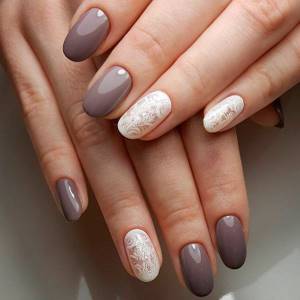
The oval shape is considered the most universal and close to naturalness. It follows the shape at the base of the nail (the part where the cuticle is located), and at the same time does not provoke increased fragility, since we do not interfere much with the natural shape of the nail. Regardless of the length of the nail, the oval looks quite elegant and visually slightly stretches the fingers. In addition, the oval shape requires minimal effort to maintain, so it is not surprising that it is considered the most popular.
Who is suitable for oval nail shapes:
This option is suitable for the vast majority, regardless of how long the fingers are and how wide the palm is. If you don’t have free time for regular shape correction, or if, due to your profession, you don’t have the opportunity to grow long nails, you can safely opt for an oval nail—you can’t go wrong.
Beauty Recipes: A Fantastic Two-Ingredient Body Butter
Types of attachments for hardware manicure
The efficiency of work largely depends on the quality of the cutters. The nozzles differ in material of manufacture, shape, length, and rigidity. They process cuticles, shape the nail bed, correct nail plates, grind and polish their surface.
Diamond cutters

Their main purpose is to correct the nail plate and polish rough skin. The specific task depends on the diameter and shape: large caps are used to remove calluses and corns, and small caps are used to treat cuticles. Notches of different shades indicate the degree of hardness. Yellows are the softest, black and blue, on the contrary, are hard.
Ceramic cutters
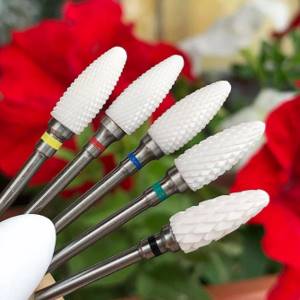
They are considered the safest option for students as they are softer than diamond and cannot cause harm if used incorrectly. Their purpose is to remove rough skin. Ceramic attachments are not used to work with nail plates. The service life is several times lower than that of diamond ones, and they require careful maintenance - regular cleaning of rough surfaces from clogged dust.
Silicone cutters
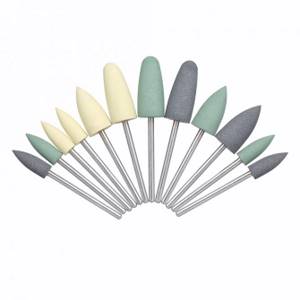
The softest type, which is used only for working with nail plates - grinding and polishing to give a natural shine. The gloss after such attachments lasts a long time and looks as natural as possible. The possibility of injuring the nail is reduced to zero.
Money issue
Removing problematic tissue can be done in different ways, and the issue here is cost. How much do various devices for combating cuticles cost:
- The manufacturer Bohema boasts affordable and high-quality products against keratinized tissue. Thus, a special remover in a pencil costs only 260 rubles.
- OPI boasts a wide variety of cuticle care products. The average cost of oil is 750 rubles.
- The Kinetics brand offers cuticle softeners and oils in the average price range of 550-600 rubles.
- The manufacturer Trind has special kits for removing problematic tissue.
- Products from the manufacturer INM have excellent reviews from customers, especially softening cuticle oil with green tea, which costs 320 rubles.
You need to focus not only on the cost of the product, but also on reviews about it, as well as on the composition. For example, the OPI and Kinetics brands boast quality products without the addition of harmful chemicals.

Kinetics
How to care for eyelash extensions is described in the article.
You should always handle the cuticle carefully so as not to damage the nail plate or cause infection. Thanks to modern means, it is possible to remove keratinized tissue completely painlessly, but when you first experience working with cuticles, it is better to contact a professional.
Sterilization of instruments
There are 4 types of sterilization:
- thermal;
- quartz;
- chemical;
- steam
According to SanPiN, the most effective methods are considered to be treatment with high temperature and pressure and exposure to an infrared sterilizer. The modern market offers a wide selection of such equipment. It is necessary to check the registration certificate of Roszdravnadzor before purchasing.

Most often, nail service studios use a dry-heat cabinet. Cleaned and disinfected instruments in craft bags are placed in it. In the device they are exposed to high temperatures from 120 to 180⁰ C for 30 minutes. This method is ideal for sterilizing cutters.
What you need to know about the structure of the nail to use a milling cutter
For the procedure to be effective and safe, you need to know some physiological features. You should start with the skin. It has 3 layers:
- Dermal – the deepest. If you touch it, it will bleed.
- Epidermal - protects the base layer from damage. But it also cannot be cut, it contains living cells.
- The horny layer is a dead layer consisting of several more layers. You can remove everything except the bottom one, otherwise regeneration processes start and the cuticle grows faster.
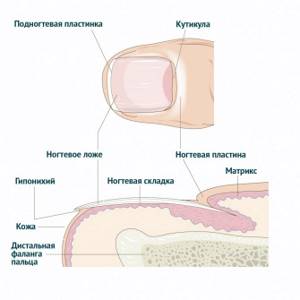
The nail plate is surrounded on three sides by skin ridges. The one located at the lower edge is called the eponychium. Its main function is to prevent harmful bacteria from entering the nail root. That is why it cannot be touched. The cuticle is the dried part of the eponychium. It is necessary to remove it along with the pterygium (skin that has grown on the plate). Based on this, it is important to consider the following points when doing a manicure:
- The nail bed contains nerve endings and capillaries. If you damage them and cut off the excess, it will hurt, after which a wound will form. It takes a very long time to heal.
- Only the stratum corneum can be processed with cutters. But you also need to not overdo it, so that the body does not begin to quickly replenish lost living cells.
- To understand whether part of the cuticle is horny or not, you need to bring your fingers close to the lamp and examine their color. If it is pink or red, you cannot touch such skin.
Choosing the right form
To have perfect nails, you need to choose the right shape. Now the most fashionable is the almond-shaped one. But it is not suitable for everyone, so you don’t need to focus only on current trends. The ideal nail shape is one that matches your cuticle line.
- Oval is the most universal, suitable for almost everyone. It is most comfortable to wear and visually lengthens the nail. In addition, this manicure looks neat and elegant.
- Round nails are best suited for those with short nails. It looks unusual and is convenient for those who lead an active lifestyle. To achieve this shape, you need to cut off all the sharp corners and make them as smooth as possible.
- Nails with sharp square corners are also quite popular. They suit owners of graceful long fingers. The manicure turns out sophisticated and neat. It is best to do this shape on medium-length nails. The main feature is that the side lines of the plate must be parallel and at right angles to the cuticle. But this type of manicure is uncomfortable to wear, and it also needs to be adjusted in time.
- The “soft square” shape is similar to the previous one, only more practical to wear. The corners are made rounded. This manicure is valued for its convenience and practicality.
- Almond-shaped should be done by girls with long graceful fingers. It looks good on medium length. All lines of the nail plate are reduced to the center and acquire an oval curve.
- The beveled shape is suitable for lovers of extravagant manicure. The technology is similar to creating a square, but an oblique cut is made at the tip. One end should be sharp and the other blunt. “Beveled” manicure should be done only on a durable plate and long nails.
- Sharp nails should only be done on long, thin, graceful fingers. But some women especially like this shape.
- Pointe shoes are also popular and suit almost everyone. This shape combines “square” and “almond”. This manicure turns out to be unusual and spectacular.
The right type of manicure is the main component of perfect nails. You can correct imperfections and highlight the advantages of your hands. In addition, it is important not only to choose the desired shape, but also to create it correctly.
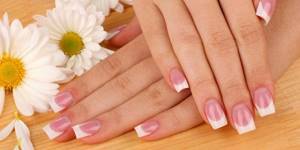
Manicure depth
When doing a deep manicure, there is a chance of damaging blood vessels. The procedure is recommended to be performed only on those nails where the hole is small or does not exist at all. Depth is contraindicated if:
- Decorative coating is not planned. The matrix is without protection, as a result the cuticle will begin to grow even faster, and a pterygium will form.
- The hole is soft and large, and the roller is flat. This is what neglected nails look like, to which the cuticle usually grows. Blood vessels appear at the site of gluing. Such skin can no longer be called dead, so it is not cut off. If you do a deep manicure, the skin will sag above the plate, which will cause hangnails.
- The nail plate or hole is deformed.
Deep treatment is also not done on the thumb.
Common mistakes made by newbies
Inexperienced nail design lovers often make unforgivable mistakes, which prevents them from getting a beautiful, high-quality manicure. Many people file their nails back and forth. Such filing destroys the nail plate and contributes to the formation of cracks, nicks, and chips. Beginners often perform manicure manipulations on softened nails. Fragility and fragility appear. Many people adjust the length with an abrasive file rather than cutting off the excess with scissors. Cover sick nails with varnish. Use blunt tweezers and scissors to cut off excess skin. They neglect the hygiene of hands and instruments.
Step-by-step hardware manicure technique
The procedure is carried out in the following sequence:
- Remove previous covering.
- Degrease hands and treat with antiseptic agents.
- Apply softening oil to the cuticle and gently move it away using an orange stick.
- Adjust the shape of the nail and its width.
- Use a cone-shaped diamond tip to remove the stratum corneum from the side ridges and open the cuticle.
- Clean the plate from the pterygium using a truncated cone cutter.
- Remove the separated part of the cuticle using a ball-shaped nozzle with minimal rigidity.
- Remove excess nail length using a cylindrical cap. Leave at least 2 mm.
- Treat the nail plates with silicone or cotton polishing cutters. You can use felt tips. The main thing is that the surface does not heat up. To do this, the device must always move without stopping.
- Remove dust with a special brush.
- Wipe your nails with degreasing lotion.
- Apply decorative coating.
- Treat your hands with oil or suitable cream. Easy to massage.
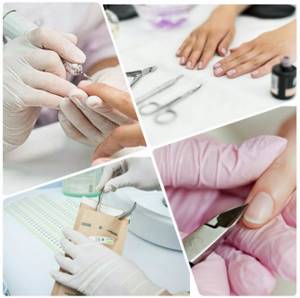
The master adapts the care process to himself, as a result, some stages may change places. But the essence remains the same: the cuticle is processed, the stratum corneum is removed from the skin ridges, the nails are given the desired shape, the plates are polished.
Rules for removing gel polish from cuticles
Often, inexperienced ladies apply gel polish not only to the nail itself, but also to the cuticle. In this case, you can remove the composition from the skin in the following ways:
- moisten a cotton swab or the tip of an orange stick in varnish solvent;
- Some masters recommend washing your hands with soap several times after the procedure, and then applying more caring cream to the fabric. Due to this, after a couple of hours it will be much easier to remove excess varnish;
- If the varnish gets on the cuticle in hard-to-reach places, you can remove it using a toothpick and a cotton wool wrapped around it, which will be soaked in a solvent.
Some masters prefer to use old brushes to combat unruly varnish, thanks to which they can remove large stains on the cuticle.
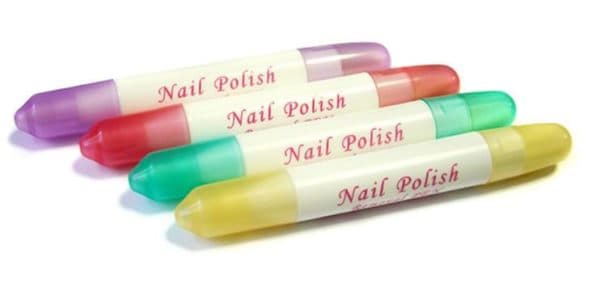
Nail Polish for removing polish
How to choose a lamp for shellac can be found here.
Safety precautions: what to pay attention to
These tips will help you avoid unexpected injuries:
- during operation, the router is held at an angle of 45⁰;
- the attachments always move along the nail - if you keep them in one area for a long time, a cut or abrasion will appear;
- no sudden movements;
- When doing manicure, do not set the speed to more than 15 thousand rpm;
- for thin and brittle nails, use ceramic cutters with fine abrasive particles; for hard ribbed plates and rough skin, use coarse abrasive diamond tips.
It is also advisable to take breaks in the operation of the device every 20 minutes (if your hands are tired and long-term treatment is needed) - this will prevent the device from overheating.
Cutters and attachments: what are they for?
In order for your nails to be processed perfectly, you need to correctly use all the proposed cutters. Professional sets include diamond-coated attachments that perfectly remove cuticles and correct the length and shape of nails. Diamond cutters are suitable for flaked and ribbed plates, larger attachments can be used for grinding rough areas of skin.
At home, it is recommended to use safe and inexpensive ceramic cutters. They significantly reduce the risk of accidental injury, but wear out quickly and require replacement. Ceramic nozzles polish nails well and cope with thin, not overgrown cuticles and rough periungual ridges.
Some kits include silicon carbide cutters. These disposable devices are ideal for home use. They do not need to be washed or disinfected; after work, the cutters are replaced with new ones. The silicon carbide option is not suitable for removing cuticles, but it perfectly shapes and polishes nails.
The standard kit includes
- discs coated with various grain sizes;
- cone-shaped and cylindrical nozzles;
- nozzle with a brush at the end;
- plastic curved spatula;
- rod with a metal ball;
- large and small abrasive rollers;
- felt polishers;
- additional nozzle for quick drying of varnish.
Tool Usage Options
To give the plates the desired shape, diamond-coated mini-discs are used. They remove length without causing splitting of nails. Larger discs are designed to treat rough skin on the fingers and periungual ridges. First, the skin is sanded with coarse-grained nozzles, and finally treated with fine abrasive discs.
Rigid trapezoidal or cylindrical cutters are designed for grinding periungual grooves. Nozzles are selected according to size; a large set can include 2-3 cylinders.
The cone-shaped cutter cleans out dead skin from hard-to-reach corners and lifts the cuticle for subsequent removal. The ball attachment is designed to remove hardened epithelium.
Small abrasive rollers sand the skin around the nails. The same larger devices with coarse grain are intended for pedicures.
Soft felt tips in the shape of a cone are designed to add shine to your nails. They will also help remove small particles of dead skin and prepare the plates for applying varnish.

Diamond dust discs are used to grind the plates.
After each session, used cutters are cleaned and washed with running water. In salons they are treated with ultraviolet light and sterilized; at home, the attachments can be wiped with any alcohol-containing liquid and dried. Cleaned attachments are stored in special cases that protect the products from dust.



